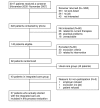An integrated care program to prevent work disability due to chronic low back pain: a process evaluation within a randomized controlled trial
- PMID: 19943976
- PMCID: PMC2791096
- DOI: 10.1186/1471-2474-10-147
An integrated care program to prevent work disability due to chronic low back pain: a process evaluation within a randomized controlled trial
Abstract
Background: In the past decade, a considerable amount of research has been carried out to evaluate the effectiveness of innovative low back pain (LBP) interventions. Although some interventions proved to be effective, they are not always applied in daily practice. To successfully implement an innovative program it is important to identify barriers and facilitators in order to change practice routine. Because usual care is not directly aimed at return to work (RTW), we evaluated an integrated care program, combining a patient-directed and a workplace-directed intervention provided by a multidisciplinary team, including a clinical occupational physician to reduce occupational disability in chronic LBP patients. The aims of this study were to describe the feasibility of the implementation of the integrated care program, to assess the satisfaction and expectations of the involved stakeholders and to describe the needs for improvement of the program.
Methods: Eligible for this study were patients who had been on sick leave due to chronic LBP. Data were collected from the patients, their supervisors and the involved health care professionals, by means of questionnaires and structured charts, during 3-month follow-up. Implementation, satisfaction and expectations were investigated.
Results: Of the 40 patients who were eligible to participate in the integrated care program, 37 patients, their supervisors and the health care professionals actually participated in the intervention. Adherence to the integrated care program was in accordance with the protocol, and the patients, their supervisors and the health care professionals were (very) satisfied with the program. The role of the clinical occupational physician was of additional value in the RTW process. Time-investment was the only barrier for implementation reported by the multidisciplinary team.
Conclusion: The implementation of this program will not be influenced by any flaws in its application that are related to the program itself, or to the adherence of patients with chronic LBP and their health care professionals. This program is promising in terms of feasibility, satisfaction and compliance of the patients, their supervisors and the health care professionals. Before implementation on a wider scale, the communication and the information technology of the program should be improved.
Figures



References
-
- Goldenhar LM, LaMontagne AD, Katz T, Heaney C, Landsbergis P. The intervention research process in occupational safety and health: an overview from the National Occupational Research Agenda Intervention Effectiveness Research team. J Occup Environ Med. 2001;43:616–622. doi: 10.1097/00043764-200107000-00008. - DOI - PubMed
Publication types
MeSH terms
Associated data
Grants and funding
LinkOut - more resources
Full Text Sources
Medical
Miscellaneous

